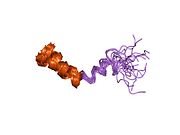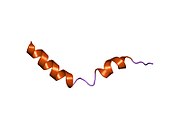Biology:Alpha-2A adrenergic receptor
 Generic protein structure example |
The alpha-2A adrenergic receptor (α2A adrenoceptor), also known as ADRA2A, is an α2 adrenergic receptor, and also denotes the human gene encoding it.[1]
Receptor
α2 adrenergic receptors include 3 highly homologous subtypes: α2A, α2B, and α2C. These receptors have a critical role in regulating neurotransmitter release from sympathetic nerves and from adrenergic neurons in the central nervous system. Studies in mice revealed that both the α2A and α2C subtypes were required for normal presynaptic control of transmitter release from sympathetic nerves in the heart and from central noradrenergic neurons; the α2A subtype inhibited transmitter release at high stimulation frequencies, whereas the α2C subtype modulated neurotransmission at lower levels of nerve activity[2]
Gene
This gene encodes α2A subtype and it contains no introns in either its coding or untranslated sequences.[1]
Ligands
Agonists
- 4-NEMD
- Brimonidine
- Clonidine
- Dexmedetomidine
- Guanfacine
- Lofexidine
- Myrcene
- Medetomidine
- PS75[3]
- Tizanidine
- Xylazine
Antagonists
- Idazoxan
- 1-PP (active metabolite of buspirone and gepirone)
- Asenapine
- BRL-44408
- Clozapine
- Lurasidone
- Mianserin
- Mirtazapine
- Paliperidone
- Risperidone
- Yohimbine
See also
References
- ↑ 1.0 1.1 "Entrez Gene: ADRA2A adrenergic, alpha-2A-, receptor". https://www.ncbi.nlm.nih.gov/sites/entrez?Db=gene&Cmd=ShowDetailView&TermToSearch=150.
- ↑ Hein, Lutz; Altman, John D.; Kobilka, Brian K. (1999). "Two functionally distinct α2-adrenergic receptors regulate sympathetic neurotransmission". Nature 402 (6758): 181–184. doi:10.1038/46040. PMID 10647009. Bibcode: 1999Natur.402..181H.
- ↑ "Structure-based discovery of nonopioid analgesics acting through the α2A-adrenergic receptor". Science 377 (6614): eabn7065. September 2022. doi:10.1126/science.abn7065. PMID 36173843.
External links
- "α2A-adrenoceptor". IUPHAR Database of Receptors and Ion Channels. International Union of Basic and Clinical Pharmacology. http://www.iuphar-db.org/GPCR/ReceptorDisplayForward?receptorID=2181.
- Human ADRA2A genome location and ADRA2A gene details page in the UCSC Genome Browser.
- Human ZNF32 genome location and ZNF32 gene details page in the UCSC Genome Browser.
Further reading
- "Differential expression of two alpha 2-adrenergic receptor subtype mRNAs in human tissues". Brain Research. Molecular Brain Research 16 (1–2): 57–63. Nov 1992. doi:10.1016/0169-328X(92)90193-F. PMID 1334200.
- "A point mutation of the alpha 2-adrenoceptor that blocks coupling to potassium but not calcium currents". Science 257 (5072): 977–80. Aug 1992. doi:10.1126/science.1354394. PMID 1354394. Bibcode: 1992Sci...257..977S.
- "Promoter region of the human alpha 2A adrenergic receptor gene". The Journal of Biological Chemistry 267 (33): 24017–22. Nov 1992. doi:10.1016/S0021-9258(18)35938-6. PMID 1385431.
- "A point mutation in the seventh hydrophobic domain of the alpha 2 adrenergic receptor increases its affinity for a family of beta receptor antagonists". The Journal of Biological Chemistry 266 (23): 15488–92. Aug 1991. doi:10.1016/S0021-9258(18)98642-4. PMID 1678390.
- "Site-directed mutagenesis of alpha 2A-adrenergic receptors: identification of amino acids involved in ligand binding and receptor activation by agonists". Molecular Pharmacology 40 (2): 168–79. Aug 1991. PMID 1678850.
- "Identification of an additional gene belonging to the alpha 2 adrenergic receptor family in the human genome by PCR". FEBS Letters 280 (2): 241–4. Mar 1991. doi:10.1016/0014-5793(91)80301-I. PMID 1849485.
- "Cloning, sequencing, and expression of the gene encoding the porcine alpha 2-adrenergic receptor. Allosteric modulation by Na+, H+, and amiloride analogs". The Journal of Biological Chemistry 265 (28): 17307–17. Oct 1990. doi:10.1016/S0021-9258(17)44904-0. PMID 2170371.
- "Cloning, sequence analysis, and permanent expression of a human alpha 2-adrenergic receptor in Chinese hamster ovary cells. Evidence for independent pathways of receptor coupling to adenylate cyclase attenuation and activation". The Journal of Biological Chemistry 264 (20): 11754–61. Jul 1989. doi:10.1016/S0021-9258(18)80130-2. PMID 2568356.
- "Cloning, sequencing, and expression of the gene coding for the human platelet alpha 2-adrenergic receptor". Science 238 (4827): 650–6. Oct 1987. doi:10.1126/science.2823383. PMID 2823383. Bibcode: 1987Sci...238..650K.
- "Evidence for high and low affinity alpha 2-receptors. Comparison of [3H]norepinephrine and [3H]phentolamine binding to human platelet membranes". The Journal of Biological Chemistry 256 (7): 3298–303. Apr 1981. doi:10.1016/S0021-9258(19)69606-7. PMID 6259160.
- "Four consecutive serines in the third intracellular loop are the sites for beta-adrenergic receptor kinase-mediated phosphorylation and desensitization of the alpha 2A-adrenergic receptor". The Journal of Biological Chemistry 270 (9): 4681–8. Mar 1995. doi:10.1074/jbc.270.9.4681. PMID 7876239.
- "Analysis of the relative interactions between the alpha 2C10 adrenoceptor and the guanine-nucleotide-binding proteins G(o)1 alpha and Gi 2 alpha following co-expression of these polypeptides in rat 1 fibroblasts". The Biochemical Journal 306 (Pt 2): 525–30. Mar 1995. doi:10.1042/bj3060525. PMID 7887906.
- "Enhanced transcription of the human alpha 2A-adrenergic receptor gene by cAMP: evidence for multiple cAMP responsive sequences in the promoter region of this gene". Cellular Signalling 6 (1): 73–82. Jan 1994. doi:10.1016/0898-6568(94)90062-0. PMID 8011430.
- "Characterization and distribution of alpha 2-adrenergic receptors in the human intestinal mucosa". The Journal of Clinical Investigation 91 (5): 2049–57. May 1993. doi:10.1172/JCI116427. PMID 8098045.
- "Gi-mediated activation of the p21ras-mitogen-activated protein kinase pathway by alpha 2-adrenergic receptors expressed in fibroblasts". The Journal of Biological Chemistry 268 (30): 22235–8. Oct 1993. doi:10.1016/S0021-9258(18)41514-1. PMID 8226727.
- "A novel interaction between adrenergic receptors and the alpha-subunit of eukaryotic initiation factor 2B". The Journal of Biological Chemistry 272 (31): 19099–102. Aug 1997. doi:10.1074/jbc.272.31.19099. PMID 9235896.
- "Gbeta gamma-independent coupling of alpha2-adrenergic receptor to p21(rhoA) in preadipocytes". The Journal of Biological Chemistry 273 (25): 15804–10. Jun 1998. doi:10.1074/jbc.273.25.15804. PMID 9624180. http://www.hal.inserm.fr/inserm-00110175/document.
- "The zeta isoform of 14-3-3 proteins interacts with the third intracellular loop of different alpha2-adrenergic receptor subtypes". The Journal of Biological Chemistry 274 (19): 13462–9. May 1999. doi:10.1074/jbc.274.19.13462. PMID 10224112.
- "Two functionally distinct alpha2-adrenergic receptors regulate sympathetic neurotransmission". Nature 402 (6758): 181–4. Nov 1999. doi:10.1038/46040. PMID 10647009. Bibcode: 1999Natur.402..181H.
- "Alpha(2) adrenoceptors regulate proliferation of human intestinal epithelial cells". Gut 47 (2): 242–50. Aug 2000. doi:10.1136/gut.47.2.242. PMID 10896916.
 |





